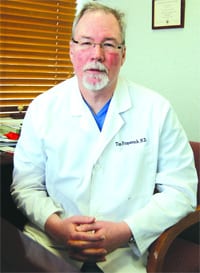SPRINGFIELD – The grand opening of Max’s Tavern at the Basketball Hall of Fame in June was a culinary delight for area diners, but also a boost for the Child-ren’s Hospital at Baystate Medical Center. Indeed, the grand opening doubled as a fundraiser for the hospital, raising $50,000 for the purchase of a nitric oxide analyzer to be used to treat young people with asthma and other lung problems, said Kathy Pappas, major gifts manager for the Baystate Health Foundation. She called the opening a huge success for the restaurant, the city’s riverfront development efforts, and patients.
Since joining the Massachusetts Nurses Association (MNA), I have watched this organization come before lawmakers in an attempt to pass legislation to regulate nurse staffing levels in Massachusetts hospitals.
I have heard the opposition. I listened to nursing and hospital administrators repeatedly claim that this legislation was not needed because there was no data to support what staff nurses were saying about the deteriorating quality of patient care caused by excessive patient loads.
However, some of the latest research that has come out in the last few years clearly and unequivocally proves that what nurses have been saying is the absolute and complete truth. It also shows that hospital staffing practices have harmed and continue to harm, and, yes, kill patients in Massachusetts hospitals.
This research has appeared in the country’s most prestigious medical and nursing journals and has been conducted by some of our nation’s preeminent nursing researchers.
The most important and the most recent of these studies was published in the October 2002 issue of the Journal of the American Medical Association, which examined the records of 232,000 surgical patients and the relationship between nurse-to-patient ratios and patient mortality and complication rates.
The results were alarming. The study reported that, the higher the patient-to-nurse ratio, the more likely there will be a death or serious complication. Each additional patient above four that a nurse is caring for produced a 7{06cf2b9696b159f874511d23dbc893eb1ac83014175ed30550cfff22781411e5} increase in mortality. If a nurse is caring for eight patients instead of four, there is a 31{06cf2b9696b159f874511d23dbc893eb1ac83014175ed30550cfff22781411e5} increase in mortality.
In the conclusion of her study, the author stated that substantial decreases in mortality rates could result from increasing registered nurse staffing, especially for patients who develop complications. She further concluded that legislation, such as that passed in California and proposed by the MNA, is a credible approach to protecting patients. She further stated, in an article published in the New England Journal of Medicine, that, “unless we create a floor for nurse staffing, we are not going to stop the flight of nurses from hospitals.”
In 2002, the New England Journal of Medicine published a study of 5 million patients in 11 states, including Massachusetts, and found a strong and consistent link between nurse staffing levels and patient outcomes.
As nurse staffing levels decreased, urinary tract infections, pneumonia, shock, upper gastrointestinal bleeding, and length of stay increased.
The study’s authors concluded that thousands of patients die every year due to understaffing, and that substantial improvements in patient care, as well as cost savings, could be realized by improving nurse staffing levels.
It is important to note that, in both studies, the authors were clear that it was the registered nurse that was the important link. In fact, in one of the studies, complications and mortality increased when more LPNs were included in the skill mix.
Finally, the Joint Commission on Accreditation of Healthcare Organizations (JCAHO), the body that inspects and provides accreditation of most hospitals, last year issued its own report stating that inadequate staffing levels have been a factor in nearly 25{06cf2b9696b159f874511d23dbc893eb1ac83014175ed30550cfff22781411e5} of the most serious life-threatening events that have been reported to the commission in the last five years. JCAHO found a link between poor staffing and 50{06cf2b9696b159f874511d23dbc893eb1ac83014175ed30550cfff22781411e5} of ventilator related incidents, 42{06cf2b9696b159f874511d23dbc893eb1ac83014175ed30550cfff22781411e5} of surgery-related incidents, 25{06cf2b9696b159f874511d23dbc893eb1ac83014175ed30550cfff22781411e5} of transfusion incidents, 19{06cf2b9696b159f874511d23dbc893eb1ac83014175ed30550cfff22781411e5} of medication errors, and 14{06cf2b9696b159f874511d23dbc893eb1ac83014175ed30550cfff22781411e5} of patient falls and patient suicides.
These are just three of the most recent studies. There are many more going back 20 years, including a Johns Hopkins study of ICU patients that found that, when an ICU nurse is given three patients instead of two, there is a 14{06cf2b9696b159f874511d23dbc893eb1ac83014175ed30550cfff22781411e5} risk in complications for those patients.
The data is clear, it is overwhelming, and it cannot be ignored — safe staffing saves lives, and the status quo for staffing in Massachusetts threatens to take many innocent lives.
The staff nurses have been right all along. The science is with them.
Dorothy McCabe, director of the Nursing Department for the Mass. Nurses Assoc., recently delivered this testimony before the state’s Joint Committee on Health Care. The MNA supports House Bill 1282, which would mandate safe-staffing ratios for hospital nurses.



